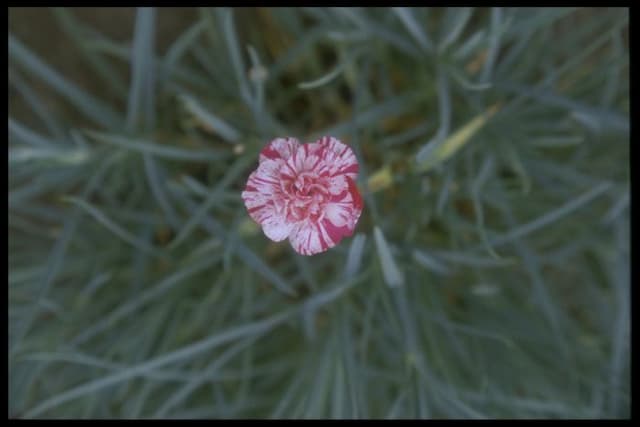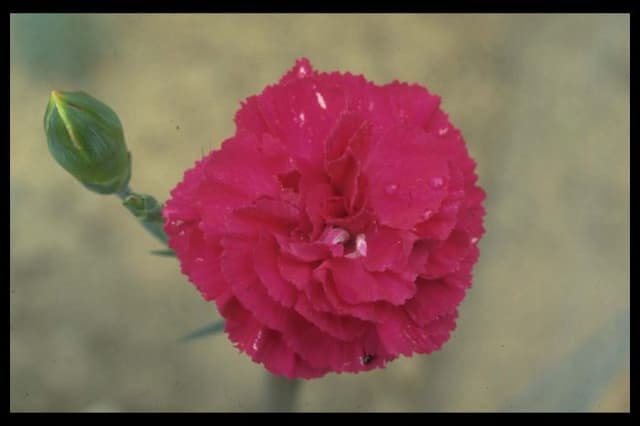Creeping Baby's Breath Gypsophila repens

ABOUT
Gypsophila repens, commonly known as creeping baby's breath, is a perennial plant with a low-growing, mat-forming habit. It is recognized for its delicate, small leaves that are narrow and gray-green in color. These leaves are often lance-shaped and cover the slender, trailing stems which spread across the ground, creating a dense foliage carpet. Throughout the blooming season, creeping baby's breath produces an abundance of petite, white or pale pink flowers. These blossoms are typically rounded, with a spray of thin petals emanating from the center, giving them a light, airy look -- often compared to a cloud or a froth of tiny bubbles. The tiny flowers are clustered at the tips of the stems, creating a soft, cloud-like effect above the greenery. The fine-textured appearance of both leaves and flowers adds a touch of whimsy and charm to garden settings, making creeping baby's breath a popular choice for rockeries, borders, and as a ground cover. Its cascading habit also renders it suitable for spill-over planting, where it can gracefully trail over edges of containers, walls, or slopes. Its attractive foliage and floral display, along with its mat-forming nature, contribute to its visual appeal and its usage in landscaping.
About this plant
 Names
NamesFamily
Caryophyllaceae.
Synonyms
Creeping Baby's Breath, Alpine Gypsophila, Repens.
Common names
Gypsophila repens var. alpestris, Gypsophila petraea, Gypsophila prostrata.
 Toxicity
ToxicityTo humans
Gypsophila repens, commonly known as creeping baby's breath, is not listed as a toxic plant to humans. However, it’s important to note that many plants can cause irritation or allergic reactions in some individuals. If ingested in large quantities, it might cause stomach upset or discomfort. As with any plant, it is advised to avoid ingesting it unless it is known to be edible and safe. If you suspect poisoning, it is important to seek medical attention.
To pets
Creeping baby's breath is also not listed as a toxic plant to pets. While it is generally considered non-toxic, it can still cause mild gastrointestinal upset if ingested in significant amounts. As with humans, individual pets may also have allergic reactions to plants, so it is best to prevent your pets from chewing on or ingesting this plant. If you notice signs of distress in your pet after ingestion, such as vomiting or diarrhea, contact your veterinarian.
 Characteristics
CharacteristicsLife cycle
Perennials
Foliage type
Deciduous
Color of leaves
Green
Flower color
White
Height
6 inches (15 cm)
Spread
1 foot (30 cm)
Plant type
Herb
Hardiness zones
3
Native area
Europe
Benefits
 General Benefits
General Benefits- Low Maintenance: Gypsophila repens, commonly known as creeping baby's breath, is a hardy perennial that requires minimal care once established, making it ideal for gardeners of all skill levels.
- Drought Tolerant: It can withstand periods of drought, which makes it suitable for xeriscaping and for gardens in dry climates.
- Erosion Control: Its mat-forming growth habit helps stabilize soil and prevent erosion on slopes and banks.
- Attracts Pollinators: The small, delicate flowers of creeping baby's breath attract bees, butterflies, and other beneficial pollinators to the garden.
- Aesthetic Appeal: With its masses of tiny white flowers, it adds a soft, airy texture to rock gardens, borders, and groundcover, enhancing the visual interest of the garden landscape.
- Used in Floral Arrangements: It is often used in fresh and dried floral arrangements for its delicate texture and ability to complement other blooms.
- Ground Cover: Its ability to spread and cover the ground quickly makes it a useful plant for suppressing weeds in the garden.
- Rapid Growth: It grows and spreads relatively fast, which allows for quick coverage of bare spots in the garden.
- Tolerates Poor Soil: This plant has the ability to grow in poor soil conditions, including rocky or sandy soils, where other plants might struggle.
- Cold Hardy: Being cold-hardy, it can survive in cooler climates and return after harsh winters.
 Medical Properties
Medical Properties- This plant is not used for medical purposes.
 Air-purifying Qualities
Air-purifying QualitiesThis plant is not specifically known for air purifying qualities.
 Other Uses
Other Uses- Gypsophila repens, also known as creeping baby's breath, can be used as a natural dye source. The plant can produce subtle colors when used in the process of dyeing fabrics.
- In model landscapes, such as those for model train environments, dried creeping baby's breath can be used to simulate miniature trees or shrubbery due to its fine, delicate structure.
- Chefs sometimes use sprigs of creeping baby's breath as an edible garnish for desserts, providing a delicate and whimsical touch to the presentation of sweets.
- Creeping baby's breath makes for a delicate and attractive addition to homemade potpourris, contributing to the visual appeal and adding a light, airy texture.
- This plant is sometimes used in creating natural art installations, with its ethereal appearance adding a touch of whimsy to outdoor nature-inspired art pieces.
- During crafting, the fine stems of creeping baby's breath can be woven into delicate wreaths or used as fillers in handmade bouquets and floral arrangements.
- In papermaking, the small flowers and stems can be incorporated into the paper pulp to create decorative, floral-embedded handcrafted papers.
- Creeping baby's breath has been used in soap making, either as an aesthetic inclusion within the soap's matrix or as a decorative topping to soap bars.
- Some photographers use creeping baby's breath in macro photography to add texture and depth to their images or to create a dreamy, soft-focus background.
- It can be used in creating festive decorations, such as lightweight, whimsical garlands for weddings, parties, or holiday décor.
Interesting Facts
 Feng Shui
Feng ShuiThe plant Baby's Breath is not used in Feng Shui practice.
 Zodiac Sign Compitability
Zodiac Sign CompitabilityThe plant Baby's Breath is not used in astrology practice.
 Plant Symbolism
Plant Symbolism- Purity: Gypsophila repens, commonly known as creeping baby's breath, often symbolizes purity due to its delicate and clean appearance, making it a popular choice for weddings and christenings.
- Innocence: Its white blossoms are frequently associated with the innocence and simplicity of childhood, reflecting an untouched and harmless nature.
- Eternal Love: Creeping baby's breath is also representative of everlasting love, and it's commonly used to adorn bouquets and arrangements meant to convey enduring affection.
- Support and Solidarity: As gypsophila can provide a beautiful backdrop for other flowers in an arrangement, it symbolizes support, suggesting the importance of standing together with loved ones.
 Water
WaterCreeping Baby's Breath (Gypsophila repens) prefers well-draining soil and does not like to be waterlogged. It should be watered thoroughly, allowing the top inch of soil to dry out before watering again. In general, watering once a week with about one gallon of water per square yard should suffice, but this may vary depending on climate and soil. During the hot summer months, you may need to water more frequently, especially if the plant is in full sun or the weather is particularly dry. In contrast, reduce watering during the cooler months to prevent root rot.
 Light
LightCreeping Baby's Breath thrives best in full sun to light shade. It should be placed in a location where it can receive at least six hours of direct sunlight each day. Morning sunlight is particularly beneficial, allowing the plant to dry out from dew or moisture, which can help prevent diseases. A spot that provides afternoon shade can be ideal in climates with extremely hot summers, as it can protect the plant from scorching heat.
 Temperature
TemperatureCreeping Baby's Breath can tolerate a wide range of temperatures. It can survive minimum temperatures between 10 to 15 degrees Fahrenheit and maximum temperatures as high as 90 degrees Fahrenheit. The ideal temperature range for promoting vigorous growth and flowering is between 60 to 75 degrees Fahrenheit. It is important to note that this plant may require protection if temperatures are expected to plummet below its minimum threshold.
 Pruning
PruningPruning Creeping Baby's Breath is essential to maintain its shape and encourage denser growth. The best time to prune is after it has finished flowering, typically in late summer or early fall. Cut back the stems by one-third to one-half, which can also help rejuvenate the plant for the following season. Regular removal of spent flowers can prolong the blooming period. Pruning every year or every other year is recommended, depending on the plant's performance.
 Cleaning
CleaningAs needed
 Soil
SoilCreeping baby's breath (Gypsophila repens) thrives in well-draining, alkaline soil with a pH range of 7.0 to 7.5. A good soil mix for this plant would consist of one part garden soil, one part coarse sand or perlite, and one part compost to provide nutrients. Mulching with gravel will assist in drainage and mimic its native alpine conditions.
 Repotting
RepottingCreeping baby's breath should be repotted every 1 to 2 years to prevent it from becoming root-bound and to replenish its soil. Repotting is best done in the spring as the plant exits dormancy and before it enters its active growing phase.
 Humidity & Misting
Humidity & MistingCreeping baby's breath prefers a dry to moderate humidity level, consistent with its native alpine habitats. It does well in average household humidity but will not tolerate overly damp conditions well.
 Suitable locations
Suitable locationsIndoor
Place in bright, indirect light and well-draining soil.
Outdoor
Full sun, well-draining soil, protect from excessive moisture.
Hardiness zone
3-9 USDA
 Life cycle
Life cycleGypsophila repens, commonly known as creeping baby's breath, begins its life as a seed, which germinates in late winter or early spring when the soil warms. The seedling emerges and develops a rosette of leaves, focusing on root and foliage growth before entering the vegetative stage. During this stage, the plant expands laterally and establishes a strong root system. As it matures, creeping baby's breath enters the flowering stage in late spring or early summer, producing clusters of small, white or pinkish flowers that attract pollinators and facilitate cross-pollination. After pollination, the plant sets seed, which then matures and is dispersed in late summer or early fall, ensuring the continuation of the species. In the final stage of its life cycle, as a perennial, creeping baby's breath may go dormant during the winter, preserving its root system for the next growing season.
 Propogation
PropogationPropogation time
Spring-early summer
The most popular method of propagating Gypsophila repens, commonly known as Creeping Baby's Breath, is by seed sowing. This should be done in early spring, after the threat of frost has passed, to allow for the longest growing season. Seeds should be sown on the surface of well-draining soil as they need light to germinate, and they should not be covered with soil. It is important to keep the soil consistently moist but not waterlogged. Germination typically takes 10 to 20 days at 65 to 70 degrees Fahrenheit (about 18 to 21 degrees Celsius). Once seedlings have developed their first true leaves and are strong enough to handle, they can be thinned out or transplanted to their final location, ensuring they are spaced about 12 to 18 inches (30 to 46 centimeters) apart to allow for spread and growth.









